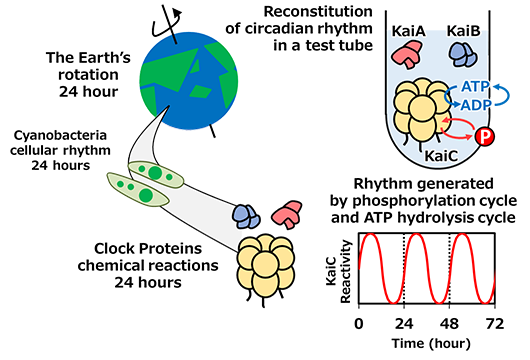Research team reveals what drives the circadian rhythms in cyanobacteria
Scientists want to increase their understanding of circadian rhythms, those internal 24-hour biological clock cycles of sleeping and waking that occur in organisms, ranging from humans to plants to fungi to bacteria. A research team has examined the complex workings of cyanobacteria and can now better comprehend what drives its circadian clock.
The team, led by researchers from the Institute for Molecular Science, National Institutes of Natural Sciences in Okazaki, Japan, published their findings on 15th April 2022 in Science Advances.
The team focused their research on KaiC, the clock protein that regulates the circadian rhythm in cyanobacteria, a type of bacteria lives in all types of water and are often found in blue-green algae (Figure 1, left panel). These biological clocks in organisms are composed of proteins (Figure 1, right upper panel). The cyanobacterial circadian clock is the simplest circadian clock as far as the number of its components, yet it is still a very complex system that can provide scientists with clues to the working of all circadian clocks. The blueish cyanobacteria are microorganisms that can be found in environments ranging from salt and fresh waters to soils to rocks. The team examined the structural basis for allostery, the complex changes that occur in shape and activity of the KaiC protein in the cyanobacteria (Figure 1, right lower panel). Allostery drives the cyanobacterial circadian clock.

Figure 1. Clock proteins generating cyanobacterial circadian rhythms.
Circadian rhythms of the phosphorylation cycle (red circle with “P” indicating the phosphor transfer) and the ATP hydrolysis cycle (blue circle with “ATP” and “ADP” indicating the conversion of adenosine-triphosphate into adenosine-diphosphate) can be observed in a test tube.
The team studied the atomic structures of the KaiC clock protein, by screening thousands of crystallization conditions. This detailed study of the atomic structures allowed them to cover the overall phosphorylation cycle, that process where a phosphate is transferred to the protein (Figure 2, lower panel). Phosphorylation cooperates with another reaction cycle, ATP hydrolysis, which is the energy consuming events determining the clock speed (Figure 2, upper panel). The phosphorylation-ATP hydrolysis system works like a regulator for the cell activity. To help them understand the basis for the allostery, they crystallized the KaiC protein in eight distinct states, allowing them to observe the cooperativity between the phosphorylation cycle and the ATP hydrolysis cycle working like two gears (Figure 2).

Figure 2. Cooperative motion of two gears rotating in KaiC
The phosphorylation cycle and the ATP hydrolysis cycle occur in the double-ring structure of KaiC. The two cycles are mediated by hydrogen bonds among acidic, basic, and neutral components.
In the past, scientists have studied the phosphorus cycle of the KaiC protein in vivio, in vitro, and in silico. Yet little was known about how allostery regulates the phosphorus cycle in KaiC.
By studying the KaiC in the eight distinct states, the team was able to observe a coupling that occurs in the phosphorus cycle and the ATPase hydrolysis cycle. This coupling of the two gears drives the cyanobacterial circadian clock.
“Because proteins are composed of a vast number of atoms, it is not easy to understand the mechanisms of their complicated but ordered functions. We need to trace the structural changes of proteins patiently,” said Yoshihiko Furuike, assistant professor at the Institute for Molecular Science, National Institutes of Natural Sciences.
The KaiC protein rhythmically activates and inactivates the reaction cycles autonomously to regulate assembly states of other clock-related proteins. So thinking about their next steps, the team might use structural biology to reveal the atomic mechanisms of acceleration and deceleration of the gear rotations. “Our goal is to see all cyanobacterial clock proteins during the oscillation at an atomic level and to describe the moment that the ordered rhythm arises from chaotic atomic dynamics,” Furuike said.
Their work can serve as a research tool, helping scientists to better understand the mechanisms at work in the circadian clock cycle. Looking ahead, the research team can see their findings having wider applications. Mammals, insects, plants, and bacteria all have their own clock proteins with distinct sequences and structures. “However, the logic behind the relationship between KaiC dynamics and clock functions can be applied to other studies on various organisms,” Furuike said.
Paper authors include Yoshihiko Furuike, Shuji Akiyama, Institute for Molecular Science, National Institutes of Natural Sciences, Okazaki, Japan
In addition to the researchers from the Institute for Molecular Science, others on the team include researchers from SOKENDAI, The Graduate University for Advanced Studies; Graduate School of Science and Institute for Advanced Studies, Nagoya University; and the Institute for Protein Research, Osaka University. Their work was funded by Grants-in-Aid for Scientific Research.
Information of the paper
Journal Name: Science Advances
Journal Title: Elucidation of master allostery essential for circadian clock oscillation in cyanobacteria
Authors: Yoshihiko Furuike, Atsushi Mukaiyama, Dongyan Ouyang, Kumiko Ito-Miwa, Damien Simon, Eiki Yamashita, Takao Kondo, Shuji Akiyama
DOI: 10.1126/sciadv.abm8990
Financial Support
Grants-in-Aid for Scientific Research (17H06165, 18K06171, 19K16061)
Contact Person
Yoshihiko Furuike
TEL: +81-564-55-7336
E-mail: furuike_at_ims.ac.jp (Please replace the “_at_” with @)
1125


